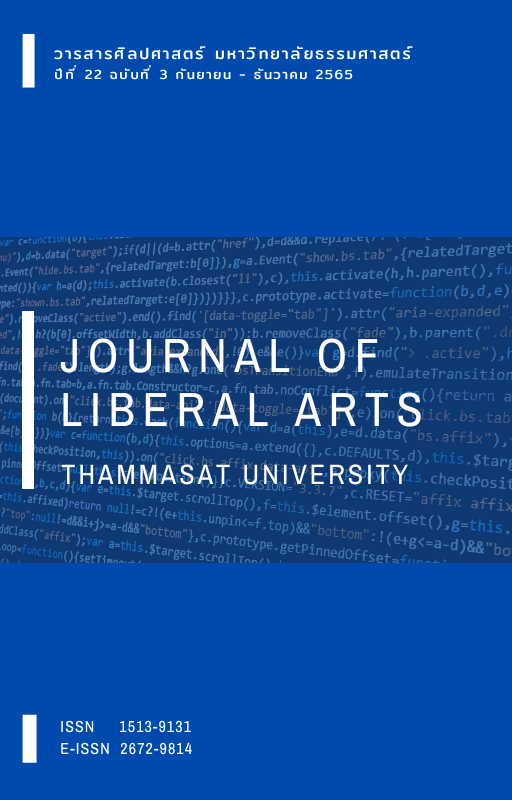ภูมิศาสตร์แห่งอารมณ์: ถ้อยคำอารมณ์ผ่านทวิตเตอร์กับสุขภาวะของประชากรเชิงพื้นที่ กรณีศึกษาพื้นที่ภาคตะวันออก
Main Article Content
บทคัดย่อ
งานวิจัยนี้มีวัตถุประสงค์เพื่อศึกษาอารมณ์ของผู้คนแต่ละจังหวัดในพื้นที่ภาคตะวันออกผ่านถ้อยคำอารมณ์บนพื้นที่ทวิตเตอร์และเพื่อวิเคราะห์ความสัมพันธ์ระหว่างถ้อยคำอารมณ์ดังกล่าวกับสุขภาวะของประชากร เชิงพื้นที่ โดยวิเคราะห์ข้อมูลที่เก็บได้จากการสำรวจบัญชีทวิตเตอร์สาธารณะของผู้คนในพื้นที่ 7 จังหวัดภาคตะวันออก เป็นจำนวนอย่างน้อยจังหวัดละ 400 บัญชี ในปี พ.ศ. 2561 สถิติที่ใช้ในการวิเคราะห์ข้อมูลคือสถิติสหสัมพันธ์ ผลการวิจัยพบว่าระดับอารมณ์ของผู้คนในพื้นที่ภาคตะวันออกที่สะท้อนผ่านถ้อยคำอารมณ์บนพื้นที่ทวิตเตอร์อยู่ในระดับปานกลางค่อนไปทางสูงและใกล้เคียงกัน โดยจังหวัดที่มีระดับคะแนนอารมณ์สูงที่สุด คือ จังหวัดชลบุรี เทียบเป็นระดับคะแนน 6.217 จาก 10 คะแนน และจังหวัดที่มีระดับอารมณ์ต่ำที่สุด คือ จังหวัดสระแก้ว เทียบเป็นระดับคะแนน 5.929 จาก 10 คะแนน ขณะที่ค่าสถิติสหสัมพันธ์บ่งชี้ว่าระดับอารมณ์ของผู้คนที่สะท้อนผ่านถ้อยคำอารมณ์บนพื้นที่ทวิตเตอร์ดังกล่าวมีความสัมพันธ์กับสุขภาวะของประชากรเชิงพื้นที่ในมิติที่เกี่ยวเนื่องกับองค์ประกอบทางด้านการมี สุขภาวะที่ดี การมีเศรษฐกิจเข้มแข็งและเป็นธรรม และการสร้างความเป็นธรรมและลดความเหลื่อมล้ำทางสังคม ของดัชนีความอยู่เย็นเป็นสุขร่วมกันในสังคมของสำนักงานสภาพัฒนาการเศรษฐกิจและสังคมแห่งชาติ โดยความสัมพันธ์ดังกล่าวอยู่ในระดับที่แตกต่างกันไป กล่าวคือ มีความสัมพันธ์สูงแบบผกผันกับสัดส่วนคนจนที่ระดับค่าสหสัมพันธ์ -0.88 และมีความสัมพันธ์ปานกลางกับอัตราผลิตภัณฑ์มวลรวมภายในจังหวัดต่อหัวที่ระดับค่าสหสัมพันธ์ 0.50 แต่มีความสัมพันธ์ในระดับต่ำกับสุขภาวะของประชากรประการอื่น ๆ
Downloads
Article Details

อนุญาตภายใต้เงื่อนไข Creative Commons Attribution-NonCommercial-NoDerivatives 4.0 International License.
เอกสารอ้างอิง
สํานักงานปลัดกระทรวงสาธารณสุข, กองยุทธศาสตร์และแผนงาน. (2561). สถิติสาธารณสุข พ.ศ. 2561. http://bps.moph.go.th/new_bps/sites/default/files/statistic%2061.pdf
พรชัย พรวิริยะกิจ และ วรินทร แดนดี. (2558). ข้อผิดพลาดในการแปลภาษาอังกฤษเป็นภาษาไทยของนักศึกษาสาขาวิชาภาษาอังกฤษเพื่อการสื่อสารสากล. วารสารสังคมศาสตร์, 4(2), 16-23.
มูลนิธิธรรมรัฐเพื่อการพัฒนาสังคมและสิ่งแวดล้อม. (2560). คู่มือการจัดทำตัวชี้วัดความอยู่เย็นเป็นสุขร่วมกันในสังคมไทยโครงการปรับปรุงดัชนีความอยู่เย็นเป็นสุขร่วมกันในสังคมไทย. https://www.nesdc.go.th/ewt_w3c/ewt_dl_link.php?filename=&nid=10787
สถานีตำรวจภูธรจังหวัดจันทบุรี. (2561). สถิติคดีอาญาที่น่าสนใจ จำแนกตามประเภทความผิด พ.ศ. 2558-2561. http://rayong.old.nso.go.th/nso/project/table/files/chtburi
สถาบันวิจัยประชากรและสังคม. (2557). รายงานสุขภาพคนไทย: ความสุข. https://www.thaihealthreport.com/index2550-004
สำนักงานคณะกรรมการเศรษฐกิจและสังคมแห่งชาติ. (2563). บัญชีประชาชาติ.http://chonburi.nso.go.th/images/ruk/63/_10_.xls
สำนักงานคณะกรรมการพัฒนาการเศรษฐกิจและสังคมแห่งชาติ. (2562). ผลิตภัณฑ์ภาคและจังหวัดแบบปริมาณลูกโซ่ ฉบับ พ.ศ. 2561 (Gross Regional and Provincial Product Chain Volume Measures 2018 Edition). https://www.nesdc.go.th/ewt_w3c/main.php?filename=gross_regional
สำนักงานสถิติจังหวัดชลบุรี. (2562). รายงานสถิติจังหวัดชลบุรี 2562. http://chonburi.nso.go.th/index.php?option=com_content&view=article&id=440:16-3-63&catid=102&Itemid=507
สำนักงานปลัดกระทรวงสาธารณสุข, ศูนย์เทคโนโลยีสารสนเทศและการสื่อสาร. (2563). รายงานการเข้าถึงบริการของผู้ป่วยโรคซึมเศร้า ปีงบประมาณ 2563 เดือนกรกฎาคม 2563 (ฐานข้อมูล HDC) (ใช้ประชากรประจําปี 2561 ในการคํานวณ). https://www.thaidepression.com/www/report/main_report/pdf/ahb-07-20_mix_HDC.pdf
ศิริวรรณ มนอัตระผดุง. (2563). การจัดตั้งเขตพัฒนาเศรษฐกิจพิเศษเพื่อรองรับการเข้าสู่ประชาคมอาเซียน. สำนักวิชาการ สำนักงานเลขาธิการวุฒิสภา. http://library.senate.go.th/document/Ext8665/8665127_0008.PDF
อารยา พุดตาล. (2560). การวิเคราะห์ทวิตเตอร์ในเหตุการณ์สวรรคตของพระบาทสมเด็จพระปรมินทรมหาภูมิพลอดุลยเดช [วิทยานิพนธ์ปริญญามหาบัณฑิต]. จุฬาลงกรณ์มหาวิทยาลัย. คลังทรัพยากรสารสนเทศอิเล็กทรอนิกส์ของจุฬาลงกรณ์มหาวิทยาลัย. http://cuir.car.chula.ac.th/handle/123456789/59629
Ahuvia, A. C. (2001). Individualism/Collectivism and Cultures of Happiness: A Theoretical Conjecture on the Relationship Between Consumption, Culture and Subjective Well-being at the National Level. Journal of Happiness Studies, 3(1), 23-36. https://doi.org/10.1023/A:1015682121103
Brereton, F., Peter, C. J., & Ferreira, S. (2008). Happiness, Geography and the Environment. Ecological Economics, 65(2), 389-396. https://doi.org/10.1016/j.ecolecon.2007.07.008
Cohen, M. A. (2008). The Effect of Crime on Life Satisfaction. The Journal of Legal Studies, 37(S2), S325-S353. https://doi.org/10.1086/588220
Dabiri, Z., & Blaschke, T. (2019). Scale matters: a survey of The concepts of scale used in spatial disciplines. European Journal of Remote Sensing, 52(1), 419- 434. https://doi.org/10.1080/22797254.2019.1626291
Dodds, P. S., Clark, E. M., Desu, S., Frank, M. R., Reagan, A. J., Williams, J. R., Mitchell, L., Harris, K. D., Kloumann, I. M., Bagrow, J. P., Megerdoomian, K., McMahon, M. T., Tivnan, B. F., & Danforth, C. M. (2015). Human language reveals a universal positivity bias. Proceedings of the National Academy of Sciences, 112(8), 2389-2394. https://doi.org/doi:10.1073/pnas.1411678112
Dodds, P. S., Harris, K. D., Kloumann, I. M., Bliss, C. A., & Danforth, C. M. (2011). Temporal Patterns of Happiness and Information in a Global Social Network: Hedonometrics and Twitter. PloS one, 6(12), e26752. https://doi.org/10.1371/journal.pone.0026752
Doherty, S. (2016). Translations| The Impact of Translation Technologies on the Process and Product of Translation. International Journal of Communication, 10, 947-969.
Ekman, P. (1992). Facial Expressions of Emotion: An Old Controversy and New Findings. Philosophical Transactions Series B Royal Society of London, 335(1273), 63-69. https://doi.org/10.1098/rstb.1992.0008
Hinkle, D. E., Wiersma, W., & Jurs, S. G. (1998). Applied statistics for thebehavioral sciences (4th ed.). Houghton Mifflin.
Mitchell, L., Frank, M. R., Harris, K. D., Dodds, P. S., & Danforth, C. M. (2013). The Geography of Happiness: Connecting Twitter Sentiment and Expression, Demographics, and Objective Characteristics of Place. PloS one, 8(5), e64417. https://doi.org/10.1371/journal.pone.0064417
O’Connor, K. J. (2017). Happiness and Welfare State Policy Around the World. Review of Behavioral Economics, 4(4), 397-420. https://doi.org/10.1561/105.00000071
Perrin, A., & Anderson, M. (2019). Share of U.S. adults using social media, including Facebook, is mostly unchanged since 2018. Pew Research Center. https://www.pewresearch.org/fact-tank/2019/04/10/share-of-u-s-adults-using-social-media-including-facebook-is-mostly-unchanged-since-2018/
Roberts, K., Roach, M. A., Johnson, J., Guthrie, J., & Harabagiu, S. (2012). Empatweet: Annotating and detecting emotions on twitter. Proceedings of the Eighth International Conference on Language Resources and Evaluation (LREC'12), Istanbul, Turkey.
Seabrook, E. M., Kern, M. L., Fulcher, B. D., & Rickard, N. S. (2018). Predicting Depression From Language-Based Emotion Dynamics: Longitudinal Analysis of Facebook and Twitter Status Updates. Journal of medical Internet research, 20(5), e168. https://doi.org/10.2196/jmir.9267
Statista. (2020). Leading countries based on number of Twitter users as of October 2020. Statista. https://www.statista.com/statistics/242606/number-of-active-twitter-users-in-selected-countries/
Stickley, A., Koyanagi, A., Roberts, B., Goryakin, Y., & McKee, M. (2015). Crime and subjective well-being in the countries of the former Soviet Union. BMC Public Health, 15(1), 1010. https://doi.org/10.1186/s12889-015-2341-x
Venigalla, A. S. M., Vagavolu, D., & Chimalakonda, S. (2020, May 6). Mood of India During Covid-19 - An Interactive Web Portal Based on Emotion Analysis of Twitter Data. Conference Companion Publication of the 2020 on Computer Supported Cooperative Work and Social Computing. https://doi.org/10.48550/arXiv.2005.02955
Wang, W., Hernandez, I., Newman, D. A., He, J., & Bian, J. (2016). Twitter analysis: Studying US weekly trends in work stress and emotion. Applied Psychology, 65(2), 355-378. https://doi.org/10.1111/apps.12065
Winskel, H. (2013). The emotional Stroop task and emotionality rating of negative and neutral words in late Thai–English bilinguals. International Journal of Psychology, 48(6), 1090-1098. https://doi.org/10.1080/00207594.2013.793800
Wu, Y., Schuster, M., Chen, Z., Le, Q. V., Norouzi, M., Macherey, W., Krikun, M., Cao, Y., Gao, Q., Macherey, K., Klingner, J., Shah, A., Johnson, M., Liu, X., Kaiser, L., Gouws, S., Kato, Y., Kudo, T., Kazawa, H., Stevens, K., Kurian, G., Patil, N., Wang, W., Young, C., Smith, J. R., Riesa, J., Rudnick, A., Vinyals, O., Corrado, G. S., Hughes, M., & Dean, J. (2016, October 8). Google's Neural Machine Translation System: Bridging the Gap between Human and Machine Translation. ArXiv, abs/ 1609.08144. https://doi.org/10.48550/arXiv.1609.08144
Yamane, T. (1973). Statistics: an introductory analysis (3th ed.). Harper and Row Publications.


